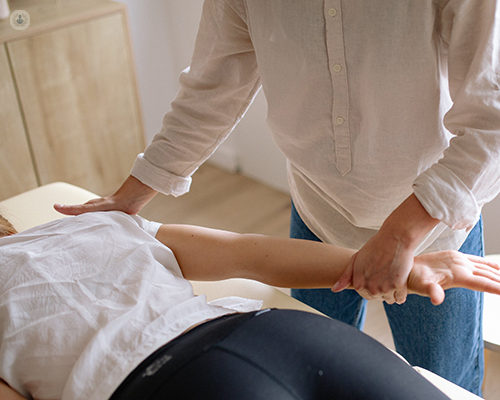Common tendonitis recovery questions
Escrito por:Tendonitis, or as it is now more accurately known, ‘tendinopathy,’ is a condition that occurs when a tendon (which is a band of fibrous connective tissue that attaches muscles to bones) becomes painful due to a process that changes the structure, blood supply and innervation of the tendon. This results in pain, thickening, swelling and stiffness. Whilst some cases of tendonitis may settle relatively simply, most will require the help of a physiotherapist to fully recover.
Here, Lucy Macdonald, highly respected chartered physiotherapist at the renowned Octopus Clinic, provides an expert insight into tendonitis recovery.

How long does it take for tendonitis to heal?
We now know that tendonitis (or ‘tendinopathy’ as it is more accurately known) is a condition that can take at least three months to heal, even with proper treatment. The structural changes that occur in tendons, which include thickening and a disruption to the blood supply, can take months or even years to reverse. Therefore, it is important to be patient and consistent with your recovery plan.
What is the best way to rest tendonitis?
Resting alone will not enable tendon recovery. In fact, it can actually make the condition worse by weakening the tendon and surrounding muscles. Instead, it is important to modify aggravating activities and gradually load the tendon in progressive increments.
How to modify aggravating activities:
- For Achilles tendinopathy, you can try wearing heel lifts in your shoes.
- For gluteus medius tendinopathy (a cause of lateral hip pain), avoid crossing your legs and avoid activities that require you to rotate your hip inward.
- For adductor tendinopathy (a cause of medial groin pain), you can try altering your running technique by widening your stance slightly to reduce load through the adductors.
- For lateral epicondylitis (otherwise known as ‘tennis elbow’), you can wear an elbow strap.
How to gradually load the tendon:
- Start with activities involving smaller ranges of motion, such as static contractions, and gradually increase the range of motion, speed, or resistance/weight over time. Only increase one of those elements at one time to make sure the increased load is controlled.
- Static contractions have been shown to reduce tendon pain. To perform a static contraction, simply hold the muscle in a contracted position for 30 seconds and repeat a few times. You should use these to control the pain throughout your recovery plan.
What exercises can I do to help my tendonitis heal?
The absolute key to the recovery of any tendinopathy is to load the tendon in progressively larger increments. This can be done through a variety of exercises, such as:
Eccentric exercises
Eccentric exercises involve lengthening the muscle while it is under tension.
We used to think these were the answer to tendon recovery because most of the early loading research was done on this type of exercise and had promising results. However, researchers have now established that, although they can be helpful, they should only make up one component of a loading programme.
Concentric contractions, where the muscle shortens as it contracts, are equally as important as static contractions. For example, with a patella tendinopathy, doing squats is a useful way of loading the tendon both eccentrically and concentrically. You can start with slow squats with a small range of motion and gradually build up to jump squats over a prolonged period of time.
Other useful exercises include:
Proprioceptive exercises
Proprioceptive exercises help to improve the body's awareness of its position in space. It can help to prevent all injuries, including tendinopathies. The exercises involve balancing with the eyes closed.
Functional strengthening exercises
Functional strengthening exercises mimic the movements you do in everyday life to strengthen muscles that support these movements and build tissue resilience. This type of exercise can make the movements you do in daily life more efficient and prepare you for a safe and gradual return to your normal activities.
For example, with a gluteus medius tendinopathy, it is better to work the muscle in a standing position rather than lying down, as this more closely mimics how the muscle is used in day-to-day and sporting activities - the ‘wall ball’ is an excellent exercise for this. You stand side on to the wall with a ball between the good knee and the wall and push the knees outwards while lifting the good leg and doing knee beds on the bad leg. You should feel it in the gluteus medius. Make sure you only do the exercise when your physiotherapist says it is safe to do so, otherwise you may have a flare up.
When can I go back to my normal activities after tendonitis?
It is important to listen to your body and follow the advice of your physiotherapist or doctor. Start with low-intensity activities and gradually increase the intensity and duration of activities over time, until you are doing them at your previous level. This may take several weeks or months.
It is normal to have low level pain during and for a few hours after the loading exercises and also when returning to normal activities. However, the pain should be mild and should not last for more than a few hours after the activity. If the pain is severe or lasts for more than a few hours, it is a sign that you are pushing yourself too hard and need to back off. This is where the guidance of an experienced physiotherapist is so important.
How can I prevent tendonitis from coming back?
The best way to prevent tendonitis from coming back is to gradually load your tendons and avoid sporadic intensive loading. You should also focus on strengthening the muscles around your tendons and those that contribute to efficient biomechanics. For example, the hip stabilisers with an Achilles tendinopathy, and the shoulder stabilisers with an elbow tendinopathy.
Here are some additional tips for preventing tendonitis:
- Warm up before exercising and cool down afterwards.
- Use proper technique when exercising.
- Wear supportive footwear.
- Take breaks when you need them.
- Listen to your body and don't push yourself too hard.
Lucy Macdonald is an esteemed chartered physiotherapist with over 20 years of experience.
If you require physiotherapy for tendonitis, don’t hesitate to book an appointment with Lucy via her Top Doctors profile today.


